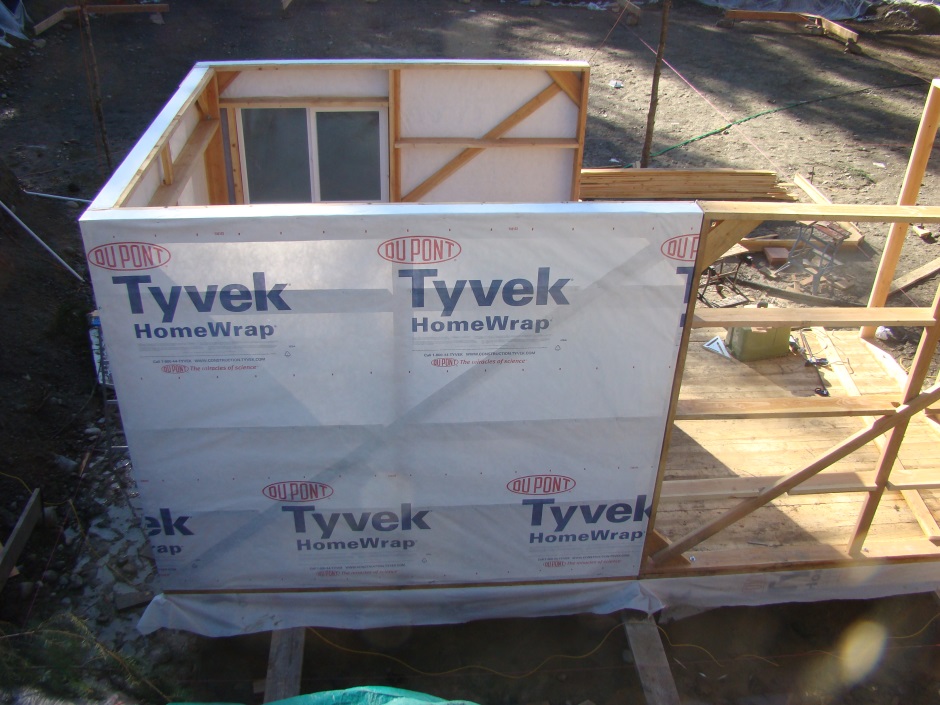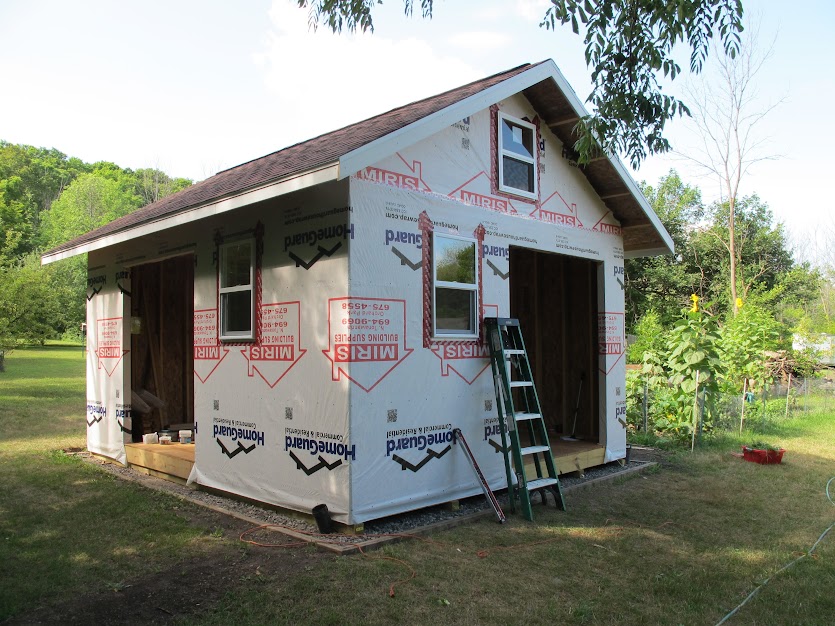A house wrap is installed between a shed’s siding and frame to protect against moisture and air infiltration, enhancing durability.
Moreover, it typically consists of a durable, synthetic material, like polyethylene or polypropylene. And designed to repel water while allowing water vapor to pass through.
This breathability is crucial to prevent the buildup of condensation and mold inside the shed. Additionally, house wraps improve energy efficiency by minimizing air leakage. It helps maintain a stable temperature inside the shed and reduces heating and cooling costs.
Further, the installation of a house wrap is a vital step in shed construction. As it significantly contributes to the shed’s longevity and overall performance.
Characteristics of a House Wrap

House wraps are crucial components in modern construction, especially for sheds and other buildings. The characteristics of a house wrap are as follows:
Material Composition
House wraps can be made from various materials, including polyethylene, polypropylene, or a combination of both. These materials are chosen for their durability, resistance to tears, and ability to repel moisture.
Dimensions
They come in rolls of varying widths and lengths, typically ranging from 9 to 10 feet wide and 100 to 200 feet long. They are designed to cover the entire exterior of a structure, including walls and roof, without any seams.
Resistance to Moisture and Air
A key characteristic of a house wrap is its ability to prevent the infiltration of moisture and air into the building envelope. This helps to maintain the integrity of the structure and prevents issues such as mold growth and energy loss.
Durability and Longevity
They are designed to withstand the elements and provide long-lasting protection. They are resistant to tears, punctures, and UV damage, ensuring that they remain effective for the lifespan of the building.
Installation Requirements
Proper installation is critical for the effectiveness of it. It must be installed according to the manufacturer’s instructions.
Proper sealing and overlapping of seams to prevent any gaps where moisture or air could enter.
Types of House Wraps

House wraps are available in several types, each with its characteristics and applications. Here are the most common types of house wraps:
Non-Woven Fabric
Made from synthetic materials like polyethylene or polypropylene fibers. Non-woven fabric house wraps are designed to resist water while allowing water vapor to pass through.
This feature prevents moisture from building up inside the walls while also providing a barrier against wind-driven rain.
Woven Fabric
Woven fabric house wraps, also known as spun-bonded fabric wraps. They are constructed from woven strands of polyethylene or other synthetic materials.
Also, they are engineered to have tiny pores that are large enough to allow water vapor to escape. But small enough to keep water droplets out. This design makes them both breathable and water-resistant.
Asphalt-Saturated Kraft Paper
This traditional house wrap is made from a paper-like material that is coated with asphalt. It is water-resistant and provides a barrier against moisture and air infiltration.
However, it is not as effective as non-woven or woven fabric wraps in terms of breathability.
Foil-Faced House Wraps
These house wraps have a layer of reflective foil on one side. It helps to block radiant heat from entering the structure.
This can be especially useful in hot climates where keeping the interior cool is a priority.
Perforated House Wraps
They are designed with tiny holes that allow water vapor to escape while still providing a barrier against liquid water. This type of wrap is particularly suitable for humid climates where condensation is a concern.
Integrated House Wraps
Some house wraps come with integrated features, such as self-adhesive strips or pre-cut openings for windows and doors. These features can help to streamline the installation process and improve the overall effectiveness of the wrap.
Benefits of Using House Wrap on a Shed

House wraps offer a range of benefits when used on sheds and other structures. Here are some of the key advantages.
Improved Moisture Protection
House wraps create an effective moisture barrier, shielding the shed from rain, snow, and other weather elements. By preventing moisture from penetrating the building envelope.
Further, the wrap helps safeguard the structural integrity of the shed and the materials within it. This can also contribute to reducing the risk of rot, mildew, and mold growth. Otherwise, it degrades the shed over time.
Enhanced Energy Efficiency
House wraps effectively seal the shed, minimizing air leakage and energy loss. By preventing air infiltration and exfiltration, they help maintain a more stable indoor environment. And reducing the need for continuous heating or cooling.
So, this results in lower energy consumption and associated costs, contributing to greater long-term sustainability and affordability.
Improved Indoor Comfort
A well-insulated and protected shed provides a more comfortable working or living space. It plays a crucial role in maintaining a consistent temperature and humidity level, making the shed more enjoyable for its occupants.
Also, by reducing drafts and cold spots, the wraps contribute to a more pleasant and functional space.
Extended Lifespan of the Structure
By minimizing exposure to moisture and other environmental factors, house wraps can significantly extend the lifespan of the shed. It protects the underlying materials from deterioration, such as wood rot, rusting of metal components, or corrosion of electrical wiring.
Hence, this helps preserve the shed’s structural integrity and aesthetics over time.
Enhanced Sustainability
House wraps contribute to more sustainable construction by reducing energy consumption and minimizing the need for frequent repairs or replacements.
Moreover, it can also contribute to better indoor air quality by preventing the infiltration of dust, pollen, and other allergens.
This can be particularly important for sheds used as workshops or storage spaces for sensitive items.
Ease of Maintenance
With proper installation, house wraps require minimal maintenance over their lifespan. Routine inspections to ensure the integrity of the wrap and any necessary repairs can help prolong its effectiveness.
Further, compared to other weather-resistant barriers, house wraps are generally easier to install and maintain. Also, reducing the need for costly and time-consuming repairs.
Versatility and Adaptability
House wraps are available in various materials and configurations, allowing for customization based on specific needs and climate conditions.
They are suitable for different types of sheds, from small storage units to larger workshops or living spaces.
Consequently, this adaptability makes them a versatile and reliable choice for a wide range of shed construction projects.
Financial Benefits
Although there is an initial cost associated with purchasing and installing a house wrap. The long-term financial benefits often outweigh this investment.
Reduced energy bills and lower maintenance costs due to energy-efficient features can lead to significant savings. Additionally, these features can increase property value, providing a higher return on investment.
What Is The Installation Process of House Wrap on a Shed?
The installation process for a house wrap on a shed typically involves several key steps. Here is a generalized outline of how to install a house wrap:
Preparation
Ensure the exterior of the shed is clean, dry, and free of any debris or protrusions. Check for any holes, gaps, or damage that need to be repaired before installing the house wrap.
Measure and Cut the House Wrap
First, measure the dimensions of the shed’s exterior walls and roof. Then, use a utility knife or scissors to cut the house wrap to the appropriate size. Allow for a minimum of 6 inches of overlap at seams and edges.
Apply the House Wrap
Start at the bottom of the wall or roof and work your way up. Unroll the house wrap and staple or tack it to the shed’s sheathing, starting at one corner.
Moreover, ensure the house wrap is taut and smooth, with no wrinkles or sagging. Overlap adjacent sections by at least 6 inches and secure with staples or nails.
Apply additional staples or nails every 12 to 16 inches along the edges and seams. Trim any excess material with a utility knife or scissors.
Seal and Tape the Seams:
Apply house wrap tape over the seams and edges of the house wrap. Make sure the tape is applied smoothly and securely, with no gaps or wrinkles.
Use a roller or hand pressure to firmly adhere the tape to the house wrap.
Install Windows and Doors
Cut openings for windows and doors in the house wrap using a utility knife or scissors. Apply a strip of flashing tape around the perimeter of the window or door opening.
Then, install the windows and doors according to the manufacturer’s instructions, ensuring they are properly sealed and flashed.
Inspect and Test the Installation
Inspect the entire house wrap installation for any gaps, tears, or other defects.
Test the house wrap by spraying it with water to ensure it effectively repels moisture. Make any necessary repairs or adjustments before proceeding.
Cover the House Wrap
Once the house wrap is properly installed and sealed. You can proceed with the installation of siding, roofing, or other exterior finishing materials.
FAQ’s
What does house wrap do?
House wrap creates an air and moisture barrier, boosting a home’s energy-efficiency and creating a healthy, comfortable indoor environment.
What is the primary purpose of Housewrap?
Housewrap functions as a weather-resistant barrier, preventing rain or other forms of moisture from getting into the wall assembly while allowing water vapor to pass to the exterior.
When should you use house wrap?
House wrap should be used as an additional line of defense against weather damage, particularly when installing vinyl siding, to protect from water damage and wind.
Final Words
A house wrap on a shed is like a waterproof coat that keeps the shed safe from rain and drafts. It’s made of strong, plastic-like material and is wrapped tightly around the outside walls and roof.
This wrap helps maintain a constant inside temperature by keeping water out. As a result, it remains colder in the summer and warmer in the winter.
So, It’s crucial to the construction of a shed since it maintains the interior sturdy, dry, and cozy.
